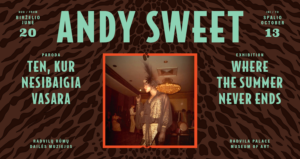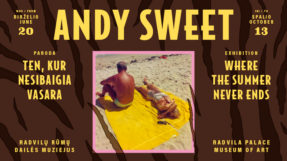Andy Sweet. Where the Summer Never Ends
20 June – 13 October 2024
 Miami Beach, and by extension the entire Florida coast, began to change rapidly in the late 1960s. Along with social change, American photography was also undergoing significant shifts, breaking away from the previously dominant humanist documentary themes and aesthetics. These changes are also evident in the work of Andy Sweet (1953–1982), a photographer from Miami Beach: in his photographs, hidden themes emerge from behind the sun-tanned bodies in the “sun and fun capital of the world”.
Miami Beach, and by extension the entire Florida coast, began to change rapidly in the late 1960s. Along with social change, American photography was also undergoing significant shifts, breaking away from the previously dominant humanist documentary themes and aesthetics. These changes are also evident in the work of Andy Sweet (1953–1982), a photographer from Miami Beach: in his photographs, hidden themes emerge from behind the sun-tanned bodies in the “sun and fun capital of the world”.
In the 1960s, a new trend began to emerge in American photography known as the social landscape. This type of documentary photography observed and reflected on the ordinary phenomena of everyday life, emphasizing the expression of the subjective point of view of the individual (rather than the common human values like before). Sweet also explored everyday themes through the juxtaposition between the environment (a sunny coastline with a seemingly ever-present air of good mood and vitality) and the subjects he observed (the elderly residents of Miami Beach). Not unlike us, the protagonists in most of the artist’s work seem to be fighting a losing battle to stop (or at least slow down) the passage of time, either masking the signs of aging, or, to the contrary, attempting to gain the upper hand over it (albeit in an illusory way) by lighting a cigarette with delight. In his series The Miami Beach Photographic Project, created with his friend and colleague Gary Monroe (b. 1951) between 1977 and 1982, Sweet interprets his surroundings without ever dissociating himself from his subjects. His images of everyday life remind us of all-encompassing feelings such as the desire to belong to a community or simply to be needed.
Sweet’s unique relationship with his surroundings also reveals itself through the expressive use of color photography. With the rising popularity of artists such as William Eggleston and Stephen Shore, color documentary photography became firmly established in American photographic art. The use of color equates the photographs with the real world, offering a captured moment in time, and bringing them even closer to the imagery of daily life. Sweet uses color to emphasize the ordinary cultural symbols in his frame: a bowling alley on the beach, the interior of a cabana, or posters for adult films. These fragments of everyday life create a sense of anxiety and loneliness that often becomes lost somewhere on the sun-drenched coastline, among all the amusing and even comical situations.
Sweet’s work also reflects certain deeper aspects of social change. Between the 1930s, when many residents of Miami Beach, including Jews, faced racial and religious discrimination, and the 1970s, when Jewish people comprised the majority of the local population and Sweet began his series, the city underwent rapid changes. This is also evident from the photographs featured in the exhibition. Thanks to the wonderful climate and improving social conditions, many Jewish Holocaust survivors moved here from Eastern Europe, including Lithuania. It is therefore unsurprising that the images captured by Andy Sweet show Jewish traditions permeating American daily life, thus conveying not only the image of a changing city but also the symbiosis of two different cultures. We can see pieces of modernist architectural heritage being part of the so-called American Shtetl—Eastern European Jewish town. When the series was being created, these Art Deco buildings were intended to be demolished and replaced by new ones in a bid to make Miami Beach more up-to-date.
One of the main groups that preserved and restored such cultural heritage was the emerging LGBTQ+* community. Having begun to actively move to Miami Beach in the 1970s, members of this community bought the run-down Art Deco buildings and, after restoring them, opened hotels, bars, and other establishments that significantly contributed to the growth of the city’s economy. In his photographs, Sweet captured some of the earliest dedicated LGBTQ+ events in Miami Beach. Through capturing drag shows (which are said to have started in Miami Beach), he emphasized the community’s substantial contribution to the city’s overall growth and popularity.
The artist tragically died in 1982, leaving behind a body of work that is an ode to his beloved city and people. By highlighting contradictions, the artist also brings forth the tensions that arise between the dominant society and the individual communities, stemming from differing worldviews, anxieties, and perhaps even fears. Seeing the people depicted in his photographs, who appear to have found peace in this never-ending summer, allows us to believe that, regardless of age, nationality, identity, political views, or experience and trauma, at a certain point in time and space, it becomes possible to stop caring about stereotypes and instead focus on learning to chart one’s own course through life.
* Although the term LGBT was more prevalent during the period in question (up to around the 1970s), this exhibition opts to use LGBTQ+, a popular label for broader forms of identity, to reflect the contemporary non-normative discourse on sexuality.
The exhibition features untitled photographs taken by Andy Sweet between 1977 and 1982. Analog photography, giclée prints
Andy Sweet’s archive was digitized by:
Stan Hughes (2010–2017, scanning, color correction)
Randy Mitchell (Darkroom & Digital) (2018–present, scanning, color correction)
Sophie Gill (2020–2022, scanning)
The photographs were scanned from test prints and contact sheets
The Lithuanian National Museum of Art is grateful to Andy Sweet’s family for donating the photographer’s collection to the museum.
Organiser LNMA Radvila Palace Museum of Art
The project is partially funded by the US Embassy
Media sponsor UAB „JCDecaux Lietuva“
Sponsor „SUN 365“
Curator Ugnė Marija Makauskaitė
Coordinator Viltė Visockaitė
Consultant Edward John Christin
Architect Sigita Simona Paplauskaitė
Graphic designer Jonė Miškinytė
Images prepared by Vaidotas Aukštaitis
- Purchase an e-ticket for this exhibition
- Get a free copy of the exhibition catalogue
- Book a guided tour of this exhibition by phone +370 616 16550, email radvilos.ekskursijos@lndm.lt
- Plan your visit to the Radvila Palace Art Museum
Radvila Palace Museum of Art,
24 Vilniaus st, LT-01402, Vilnius, Lithuania
+370 5 250 5824














